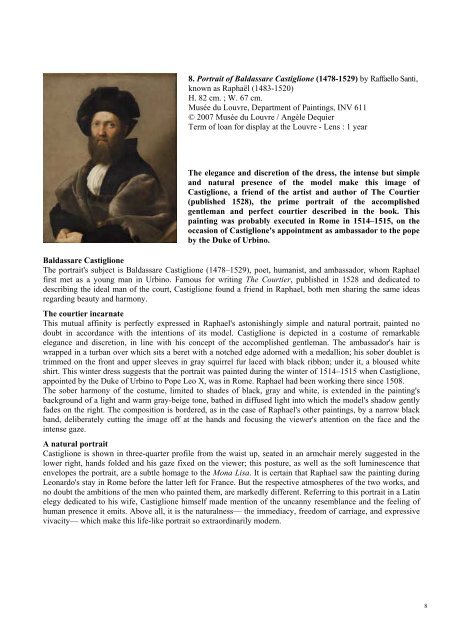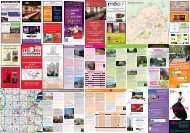The Galerie du Temps at the Louvre-Lens A unique presentation of ...
The Galerie du Temps at the Louvre-Lens A unique presentation of ...
The Galerie du Temps at the Louvre-Lens A unique presentation of ...
You also want an ePaper? Increase the reach of your titles
YUMPU automatically turns print PDFs into web optimized ePapers that Google loves.
8. Portrait <strong>of</strong> Baldassare Castiglione (1478-1529) by Raffaello Santi,<br />
known as Raphaël (1483-1520)<br />
H. 82 cm. ; W. 67 cm.<br />
Musée <strong>du</strong> <strong>Louvre</strong>, Department <strong>of</strong> Paintings, INV 611<br />
© 2007 Musée <strong>du</strong> <strong>Louvre</strong> / Angèle Dequier<br />
Term <strong>of</strong> loan for display <strong>at</strong> <strong>the</strong> <strong>Louvre</strong> - <strong>Lens</strong> : 1 year<br />
<strong>The</strong> elegance and discretion <strong>of</strong> <strong>the</strong> dress, <strong>the</strong> intense but simple<br />
and n<strong>at</strong>ural presence <strong>of</strong> <strong>the</strong> model make this image <strong>of</strong><br />
Castiglione, a friend <strong>of</strong> <strong>the</strong> artist and author <strong>of</strong> <strong>The</strong> Courtier<br />
(published 1528), <strong>the</strong> prime portrait <strong>of</strong> <strong>the</strong> accomplished<br />
gentleman and perfect courtier described in <strong>the</strong> book. This<br />
painting was probably executed in Rome in 1514–1515, on <strong>the</strong><br />
occasion <strong>of</strong> Castiglione's appointment as ambassador to <strong>the</strong> pope<br />
by <strong>the</strong> Duke <strong>of</strong> Urbino.<br />
Baldassare Castiglione<br />
<strong>The</strong> portrait's subject is Baldassare Castiglione (1478–1529), poet, humanist, and ambassador, whom Raphael<br />
first met as a young man in Urbino. Famous for writing <strong>The</strong> Courtier, published in 1528 and dedic<strong>at</strong>ed to<br />
describing <strong>the</strong> ideal man <strong>of</strong> <strong>the</strong> court, Castiglione found a friend in Raphael, both men sharing <strong>the</strong> same ideas<br />
regarding beauty and harmony.<br />
<strong>The</strong> courtier incarn<strong>at</strong>e<br />
This mutual affinity is perfectly expressed in Raphael's astonishingly simple and n<strong>at</strong>ural portrait, painted no<br />
doubt in accordance with <strong>the</strong> intentions <strong>of</strong> its model. Castiglione is depicted in a costume <strong>of</strong> remarkable<br />
elegance and discretion, in line with his concept <strong>of</strong> <strong>the</strong> accomplished gentleman. <strong>The</strong> ambassador's hair is<br />
wrapped in a turban over which sits a beret with a notched edge adorned with a medallion; his sober doublet is<br />
trimmed on <strong>the</strong> front and upper sleeves in gray squirrel fur laced with black ribbon; under it, a bloused white<br />
shirt. This winter dress suggests th<strong>at</strong> <strong>the</strong> portrait was painted <strong>du</strong>ring <strong>the</strong> winter <strong>of</strong> 1514–1515 when Castiglione,<br />
appointed by <strong>the</strong> Duke <strong>of</strong> Urbino to Pope Leo X, was in Rome. Raphael had been working <strong>the</strong>re since 1508.<br />
<strong>The</strong> sober harmony <strong>of</strong> <strong>the</strong> costume, limited to shades <strong>of</strong> black, gray and white, is extended in <strong>the</strong> painting's<br />
background <strong>of</strong> a light and warm gray-beige tone, b<strong>at</strong>hed in diffused light into which <strong>the</strong> model's shadow gently<br />
fades on <strong>the</strong> right. <strong>The</strong> composition is bordered, as in <strong>the</strong> case <strong>of</strong> Raphael's o<strong>the</strong>r paintings, by a narrow black<br />
band, deliber<strong>at</strong>ely cutting <strong>the</strong> image <strong>of</strong>f <strong>at</strong> <strong>the</strong> hands and focusing <strong>the</strong> viewer's <strong>at</strong>tention on <strong>the</strong> face and <strong>the</strong><br />
intense gaze.<br />
A n<strong>at</strong>ural portrait<br />
Castiglione is shown in three-quarter pr<strong>of</strong>ile from <strong>the</strong> waist up, se<strong>at</strong>ed in an armchair merely suggested in <strong>the</strong><br />
lower right, hands folded and his gaze fixed on <strong>the</strong> viewer; this posture, as well as <strong>the</strong> s<strong>of</strong>t luminescence th<strong>at</strong><br />
envelopes <strong>the</strong> portrait, are a subtle homage to <strong>the</strong> Mona Lisa. It is certain th<strong>at</strong> Raphael saw <strong>the</strong> painting <strong>du</strong>ring<br />
Leonardo's stay in Rome before <strong>the</strong> l<strong>at</strong>ter left for France. But <strong>the</strong> respective <strong>at</strong>mospheres <strong>of</strong> <strong>the</strong> two works, and<br />
no doubt <strong>the</strong> ambitions <strong>of</strong> <strong>the</strong> men who painted <strong>the</strong>m, are markedly different. Referring to this portrait in a L<strong>at</strong>in<br />
elegy dedic<strong>at</strong>ed to his wife, Castiglione himself made mention <strong>of</strong> <strong>the</strong> uncanny resemblance and <strong>the</strong> feeling <strong>of</strong><br />
human presence it emits. Above all, it is <strong>the</strong> n<strong>at</strong>uralness— <strong>the</strong> immediacy, freedom <strong>of</strong> carriage, and expressive<br />
vivacity— which make this life-like portrait so extraordinarily modern.<br />
8



